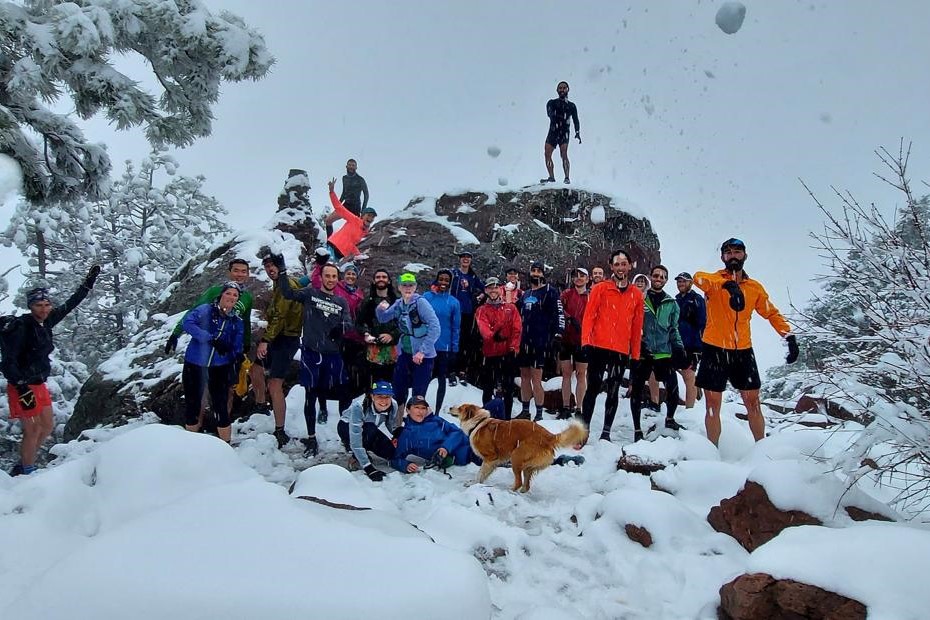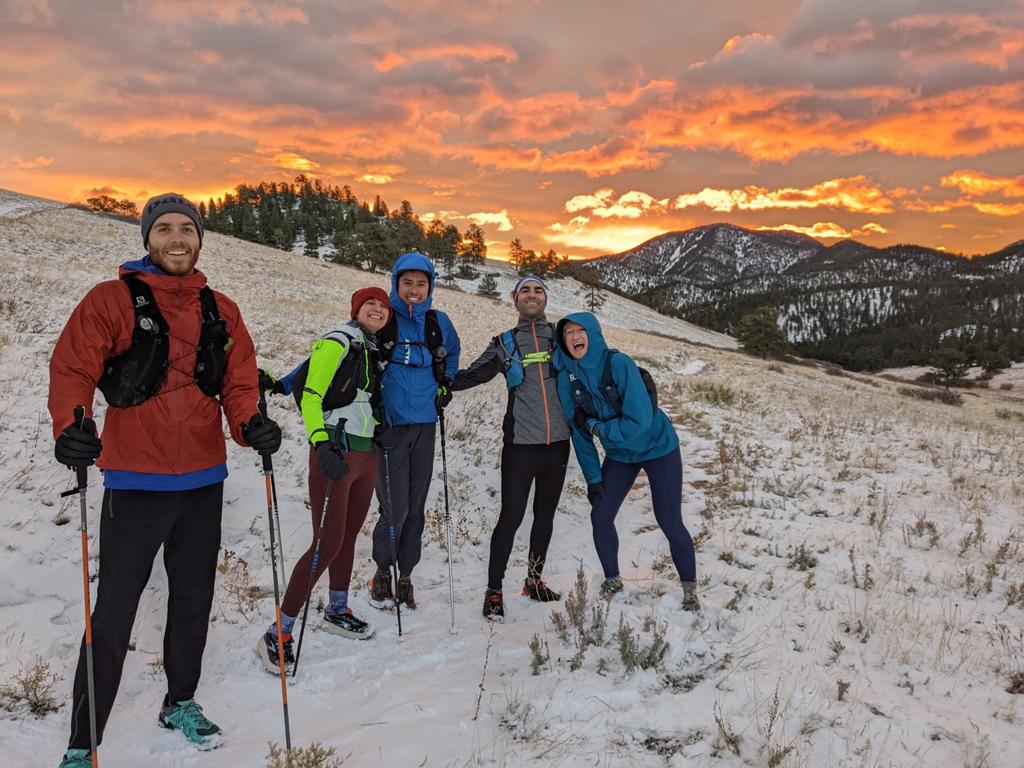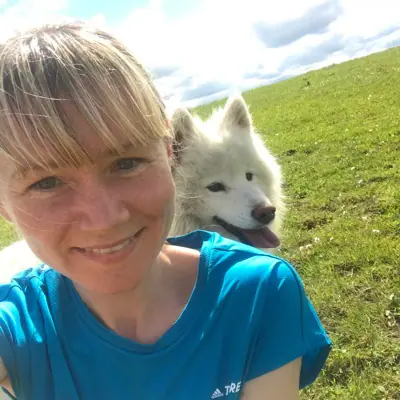For regular attendees at U.S. trail ultramarathons such as the High Lonesome 100 Mile, Leadville 100 Mile, and Western States 100, you might be familiar with a particular green singlet branded RMR — and the rapturous cheering which will erupt when one of these singlets passes through a checkpoint or crosses the finish line of a race. These are the Rocky Mountain Runners (RMR). They travel in great numbers and bring the solidarity and team spirit to ultramarathon racing, which can sometimes be lacking in individual sports. Over the course of its 10-year history, Rocky Mountain Runners has greatly impacted the running culture of its native Boulder, Colorado, and the lives of its now hundreds of green-clad members.
Rocky Mountain Runners, based in Boulder, at the foothills of the Rocky Mountains, was originally founded by husband-and-wife duo Silke Koester and Ryan Smith, who sought to replicate the running club scene they had experienced in both the U.K. and New York. Koester said, “We started in about July 2013, and then our first race, where a few of us showed up with our official name and shirts, was the Leadville 100 Mile.”
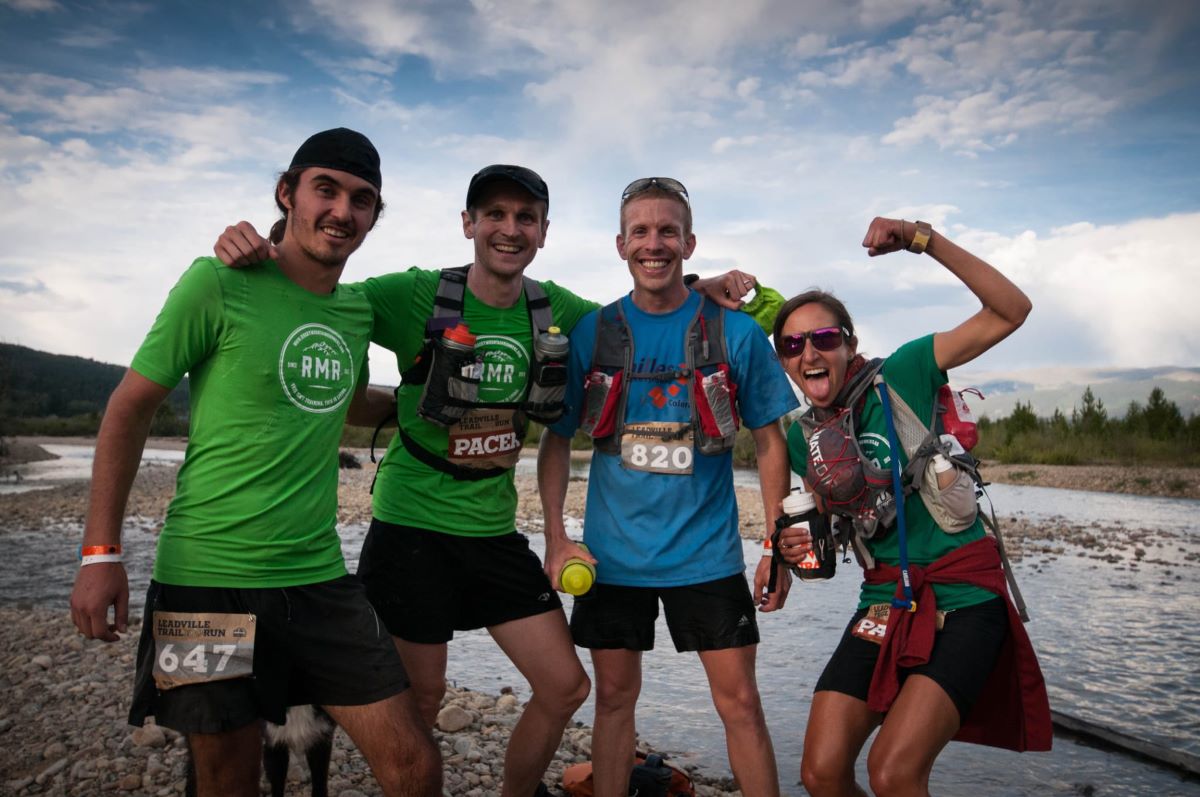
Rocky Mountain Runners halfway through the Leadville 100 Mile in 2013. Photo courtesy of Silke Koester.
Smith, who is originally from the U.K., had lived in London, England, and Edinburgh, Scotland, before moving to the U.S. Koester recounts, “The history of running and the British fell running scene was something he was pretty familiar with. Running is a big part of the culture in Britain, and the club scene goes back really far, and people show up to all the local races, no matter how big or small, with their club colors on, which have been the same for years. And it doesn’t matter if you are front-of-the-pack or back-of-the-pack, people represent their club.”
When the couple moved to New York City, a city that would appear on the surface to be poles apart from the remote fells of the U.K., they found a surprising commonality in the city’s running club culture. Koester said, “When we lived in New York City, the running scene is huge there. There’s hundreds of clubs, and at any local New York City road race you go to, you see the Dashing Whippets, the New York Harriers, and the Central Park Track Club. All of them are also always wearing their shirts. Ryan and I were part of this group called the Reservoir Dogs in New York, so we got to experience that community here in America.”
Upon moving to Colorado — eager to make themselves at home on the trails of the Rocky Mountains — the couple found themselves at a loss to find an equivalent of the community they had experienced in both the U.K. and New York and the sense of belonging that comes with representing a club and wearing its colors.
Koester recounts, “We were a little bit surprised that that didn’t really exist here. There were a lot of groups of runners, in terms of coaching programs or group runs that were affiliated with a store or a brand, but there was nothing that was more community oriented. There was the Boulder Trail Runners group that had been going for a long time. That was the closest we found, but it still didn’t fit exactly what we were looking for. So we just decided to start our own.”
She added, “On a road trip back from a run in the desert, we were brainstorming names and colors, and I think we bought the URL then as we were driving through Utah!”
Koester and Smith enlisted some of their friends to attend the runs to help get the ball rolling. For the first few months, the group was slow to get off the ground, but gradually more and more people started to show up at the trailhead for runs, and — crucially — they kept coming back.

The early days. Rocky Mountain Runners at the Imogene Pass Run in Telluride, Colorado, in 2013. Photo courtesy of Silke Koester.
In the beginning, Koester and Smith were the main run leaders, with Koester leading the Wednesday morning run and both attending the Monday evening run. The group has expanded now and currently has eight to 10 leaders — and the founding couple has taken a step back from its day-to-day management — but these Monday evening and Wednesday morning runs are still at the core of the Rocky Mountain Runners’s weekly offering.
Although still nowhere near the depth of the club scene in New York or the U.K., more groups with a similar ethos have been emerging in the region in the years since Rocky Mountain Runners’s formation. One such is Golden Mountain Runners. Koester says, “We have a lot of friends from Golden, Colorado, who used to come up to the RMR runs, and then some of them asked, ‘Do you think we could copy RMR in Golden?’ So they started Golden Mountain Runners, and it’s great. They are just 20 minutes down the road — their color is blue, our color is green. So you’re starting to see that pop up.”
Around 2016, when Koester and the other RMR runners began to notice more and more similar groups within the area, they decided to organize an annual gathering of running clubs/groups within about an hour-and-a-half radius of Boulder. Koester said, “We do a potluck in the summer and then organize random teams, where one person from each club is on a team, for a relay of sorts. And then afterward, we eat and mingle. We get to know each other from the various clubs — we’re trying to build this larger community made up of smaller communities.”
Eric Lee has been a leader with Rocky Mountain Runners since late 2013, not long after its inception. He reiterated that the aim of the group was never just about getting together to run — but rather to bolster the community. He said, “Previously, there were a lot of different run groups, but there wasn’t much community built around those. What we wanted was not just a group of people that meet up for a run once in a while, but people who are friends and meet up to do other things, and it’s not just about the running.”
He added, “In the early days, there were 15 to 20 of us, and runs would be three to five people at a time usually. We had two scheduled runs per, and then we would self-plan at weekends if people wanted to head out together. It was a small group, and everybody knew everybody.”
As the group has grown to multiples of its original size, with individual runs now often involving more people than did the entire group in its early days, the ethos of building community and friendships around the sport has remained the same.
Lee said, “We have three regular runs throughout the week. The Monday Green Mountain run, which is one of our emblematic mountains in Boulder, has been a staple since the beginning of the group. It’s every Monday, at 5:30 p.m. We go up and run — it’s about an hour and 40 minutes to an hour 50 minutes of running — then we go back and grab some beers and burgers at the local pub. And aside from a few natural disasters, that’s been happening every week since 2013.”
Although the runs are non-competitive and supportive, the group is known for being, in the majority, fairly strong runners. As Lee says, “The Monday run tends to be a little more aggressive as it’s up-and-down, 2,500 feet of vertical. The Wednesday run is more chill, a little more relaxed. There are different runs with different intentions and paces throughout the week.”
The Wednesday run is held in the morning and can therefore cater to people with different schedules than the Monday evening run. In place of the post-run burgers and beers, it has become a tradition for the group to retire to a local café afterward for breakfast.
Although the group is already closer to gender parity than the sport of trail running as a whole, they are still making efforts to recruit more women runners and have added a monthly women-only run on Thursday evenings to their repertoire of activities.
There is a forum for community members to arrange their weekend runs together, and Lee says, “There is always someone to join, whether it’s a 40-minute tempo run or a 30-mile trail run!”
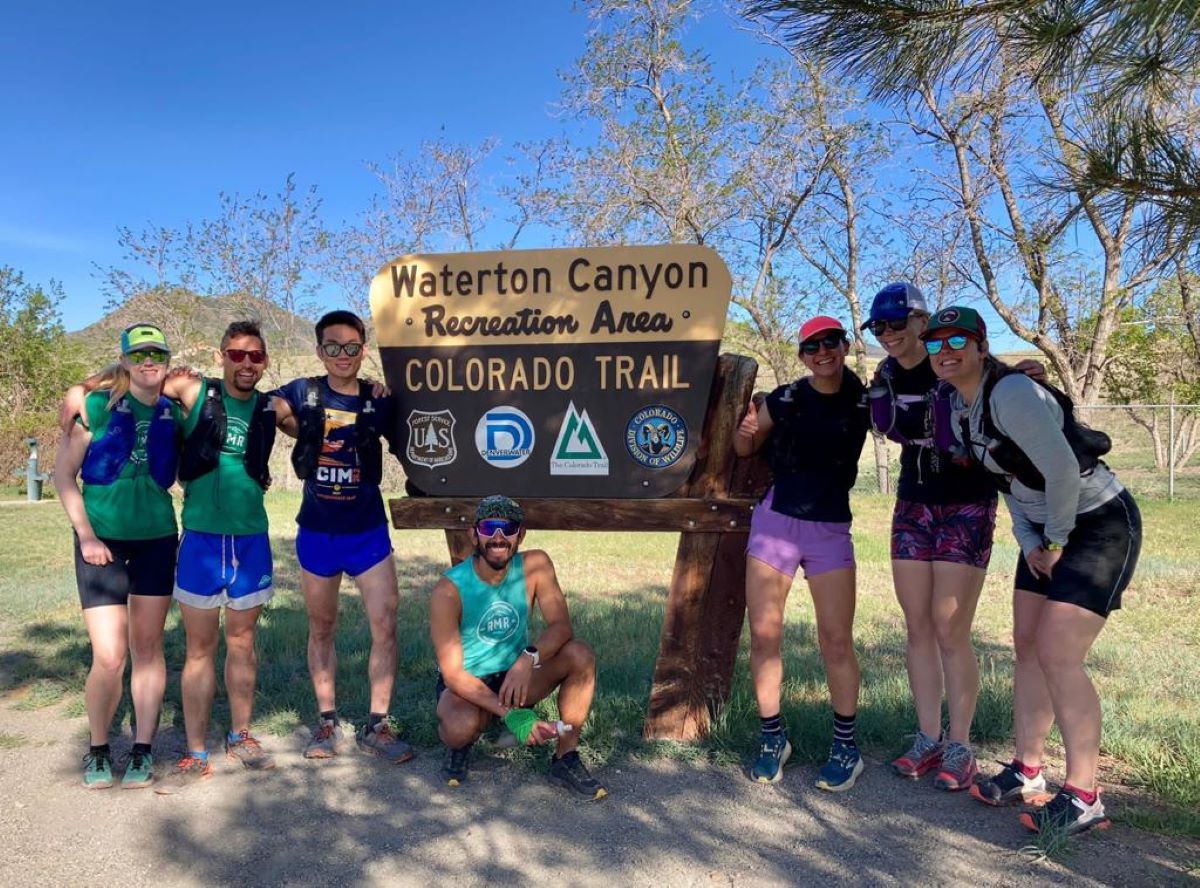
Members of the Rocky Mountain Runners running a section of the Colorado Trail in May 2022. Photo courtesy of Maggie Perkoff.
There are designated leaders for the runs, which continue year-round, with good numbers in attendance right through — typically 20 to 25 runners per session in winter and up to 40 in summer. Permit limits on the mountain in the summer mean that groups must be capped at 25, so often, in the busier season, the runners will divide into two groups.
Runners come to RMR from a range of athletic backgrounds and disciplines — some road runners, some track athletes, and some from thru-hiking backgrounds — but Lee estimates that around a two-thirds majority are interested in particular in ultrarunning.
Every year, ultrarunners from Rocky Mountain Runners travel together to a number of races, wearing their club colors and representing their community. Those who aren’t racing will often come along to help out by pacing and crewing or just cheering for their teammates. This year, a strong contingent will be traveling to California for the Miwok 100k. Lee said, “I think we have 15 or 16 people running the race … we have a Discord channel for coordinating a lot of these events. There’s typically a lot of coordination coming up to races — organizing pacers, crew, and support people as well.”
Megan Hetzel is a Rocky Mountain Runners run leader. She’s been running with the group consistently since the fall of 2020, having been encouraged to join the group by another leader, whom she had raced alongside at track in college. She said, “I started going to RMR more often and really started to make more friends through the group.” She added, “I was always going to the Monday run, and that was so intimidating. The Monday run is so hard! So, I started going to Wednesdays, and it’s so much fun.”
A year on, once Hetzel was an established regular at the Wednesday run, the group found itself short on leaders, and she was asked if she would step up.
Herself a strong runner and a competitive athlete in her college days, Hetzel pointed to the overall high standard of runners in the Boulder area, which along with the great routes in the Rockies, makes it the perfect place to train and run in challenging company. She said, “Boulder is one of those places where the average athlete seems to be pretty strong.” She added, “The group is pretty solid. You definitely have to rise to the occasion!”
Chantal Elmore, a Rocky Mountain Runners regular attendee, moved to Colorado in mid-2020 from the state of Georgia, where the trail running scene was smaller and more close-knit. She described the challenges of finding a new tribe in Colorado during the COVID-19 pandemic and said, “Trying to find a group was much more difficult in the pandemic, but for me, finding a group of similar people was really important.” A friend of a friend told her about Rocky Mountain Runners, and she said, “Within the first week that I was out there, I went to a Green Mountain run and instantly felt like, ‘These are my people.’”
Elmore works as a physical therapist and now endeavors to schedule her work week around Rocky Mountain Runners, which has been invaluable to her settling into her new home. She said, “Being a total newbie, I knew only a couple of people when I moved to Colorado, and now I would say our primary friend group revolves around Rocky Mountain Runners.”
Maggie Perkoff also moved to Colorado mid-COVID-19 pandemic in August 2020 and found the group an invaluable social resource during such a challenging time. She said, “I just wanted to meet people, so I Googled ‘Free trail running group, Boulder.’ And Rocky Mountain Runners was the first one that showed up!” She is now a regular attendee at the Monday Green Mountain run and said, “It’s the best part of my week! We run up a mountain and go to the pub after, and it’s just a really great way to start the week.”
Perkoff added, “For the past two and a half years, it’s been such a positive thing in my life that this group exists. Every week, it got me through a lot of the pandemic stress.”
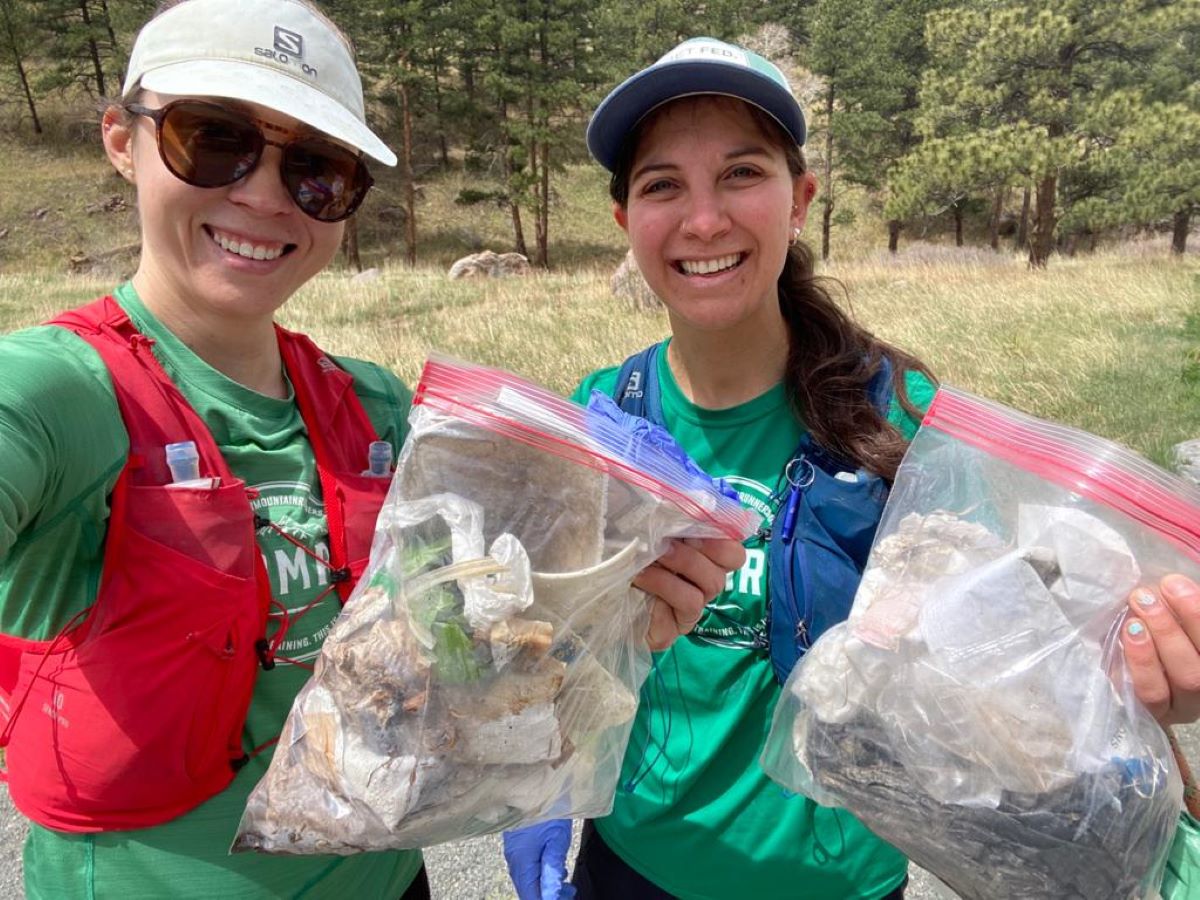
Maggie Perrkoff (right) with RMR runner Abby Hughes on the group’s annual Earth Day trail clean-up. Photo courtesy of Maggie Perkoff.
As the main U.S. racing season kicks off over the next couple of months, we will hopefully be seeing lots of green RMR shirts out racing, crewing, and supporting. And if Rocky Mountain Runners’s overarching goal continues to be successful, we’ll also be seeing lots of new club colors popping up around the region into the future.
Call for Comments
- Have you seen the Rocky Mountain Runners and their distinctive green shirts? Have you run with them?
- Do you know of any similar groups or clubs in your area?
